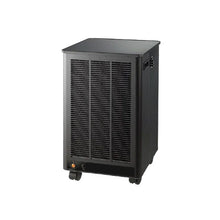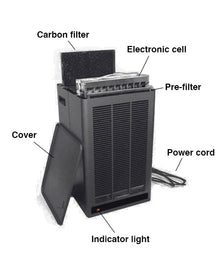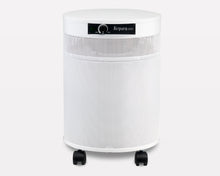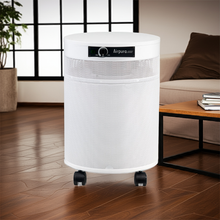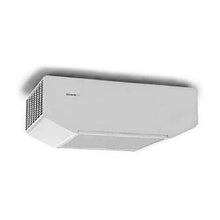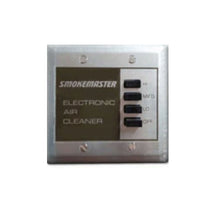Beyond the Haze: How Top Commercial Air Purifiers Eradicate Smoke and Odors in All Types of Businesses

Walk into any well-managed commercial space, and you'll notice something immediately: the air feels clean and fresh, regardless of what activities take place there. Whether it's a bustling restaurant kitchen, a manufacturing facility, or a designated smoking lounge, the best businesses understand that air quality directly impacts employee productivity, customer satisfaction, and their bottom line.
The challenge isn't just removing visible smoke—it's eliminating the microscopic particles, volatile organic compounds (VOCs), and persistent odors that can linger for hours or even days after the source is gone. This is where commercial-grade air purification systems prove their worth, going far beyond what residential units can achieve.
The Science Behind Effective Commercial Smoke Removal
When we talk about smoke removal, we're dealing with particles that range from visible chunks of ash down to ultrafine particles measuring just 0.1 microns. To put this in perspective, human hair is about 50-100 microns wide, meaning some smoke particles are 500 times smaller than what you can see with the naked eye.
Research published in environmental health journals demonstrates the effectiveness of commercial air purification systems. A comprehensive study on HEPA filter effectiveness found that "air cleaners (with HEPA filters) placed in the room chamber effectively reduced the PM concentration to a large extent" when dealing with particulate matter commonly found in smoke. The same research showed that mechanical filtration systems consistently outperformed ionizing purifiers across different indoor environments.
What makes commercial systems different from residential units isn't just size—it's engineering. True HEPA filters can "theoretically remove at least 99.97% of dust, pollen, mold, bacteria, and any airborne particles with a size of 0.3 microns" according to EPA standards. However, commercial units combine this filtration power with higher air exchange rates, meaning they can process the entire volume of air in a space multiple times per hour.
Why Standard Ventilation Falls Short
Many business owners assume their existing HVAC system handles air quality adequately. While standard ventilation systems excel at temperature control and basic air circulation, they're not designed to tackle the specific challenges that smoke and odors present.
Think of your HVAC system as a highway—it moves large volumes of air efficiently from point A to point B. But when you need to remove specific contaminants, you need something more like a high-tech filtration plant. Commercial smoke eaters are designed with this precision in mind, targeting the exact particle sizes and chemical compounds that create lasting problems.
The difference becomes apparent in spaces where smoking is permitted or where cooking, manufacturing, or other processes generate airborne contaminants. A restaurant without proper smoke removal might find odors settling into upholstery and walls, creating an unpleasant environment that drives customers away. A manufacturing facility might struggle with worker complaints about air quality, leading to decreased productivity and potential health concerns.
Key Technologies That Make the Difference
The most effective commercial air purifiers combine multiple filtration technologies to address different aspects of smoke and odor removal:
Multi-Stage HEPA Filtration forms the backbone of serious smoke removal systems. These aren't the basic HEPA filters you might find in a home unit—commercial versions are built to handle higher volumes and more challenging contaminants while maintaining their efficiency over extended periods.
Activated Carbon Systems tackle the chemical side of the equation. While HEPA filters excel at capturing particles, activated carbon absorbs the volatile organic compounds and gases that create persistent odors. The best commercial systems use specially treated carbon that's optimized for specific types of contaminants.
Pre-filtration Stages extend the life of expensive HEPA and carbon filters by capturing larger particles before they reach the main filtration media. This isn't just about cost savings—it ensures consistent performance even in demanding environments.
Variable Speed Controls allow these systems to adapt to changing conditions. During peak activity periods, they can ramp up to maximum capacity. During quieter times, they can operate at lower speeds to save energy while maintaining baseline air quality.
Sizing and Placement: Getting the Math Right
One of the biggest mistakes we see in commercial installations is undersizing the air purification system. Unlike residential spaces where you might get away with a unit that's slightly too small, commercial environments demand precise calculations based on room volume, occupancy levels, and the specific types of contaminants being generated.
Commercial applications typically "require 30% more filtration" than private use due to higher occupancy rates and more challenging conditions. This isn't just about having a bigger unit—it's about ensuring adequate air changes per hour to maintain consistent air quality throughout the space.
Placement matters just as much as sizing. The most powerful air purifier in the world won't be effective if it's positioned where it can't access contaminated air or where its clean air output is immediately diluted. Professional installations consider air flow patterns, heat sources, and occupancy patterns to optimize performance.
Industry-Specific Considerations
Different types of businesses face unique air quality challenges that require tailored solutions:
Restaurants and Food Service operations deal with cooking smoke, grease particles, and food odors that can quickly overwhelm standard ventilation systems. The key is capturing contaminants at their source while maintaining comfortable dining conditions.
Manufacturing Facilities might need to address chemical vapors, welding fumes, or industrial dust alongside traditional smoke concerns. The air purification system needs to integrate with existing safety protocols and workplace health requirements.
Hospitality Venues including hotels with designated smoking areas face the challenge of preventing odor migration to non-smoking areas while maintaining guest comfort. This requires strategic placement and carefully calibrated airflow management.
Healthcare Facilities have some of the most stringent air quality requirements, needing to remove not just smoke and odors but also potential biological contaminants. The air purification system must meet medical-grade standards while operating quietly enough not to disturb patients.
The Economics of Clean Air
Investing in a quality commercial air purification system isn't just about compliance or comfort—it's a business decision that impacts your operations in measurable ways. Clean air reduces employee sick days, increases customer dwell time, and protects your physical assets from smoke and odor damage.
Consider the cost of deep cleaning carpets, repainting walls, or replacing furniture that's been damaged by persistent smoke exposure. A commercial-grade air purifier pays for itself by preventing these problems rather than just addressing them after they occur.
Energy efficiency has improved dramatically in recent commercial air purification systems. Modern units use advanced motor technologies and smart controls that adjust operation based on real-time air quality measurements. This means you're not wasting energy over-purifying clean air or under-purifying contaminated air.
Making the Right Choice for Your Business
When evaluating commercial air purification systems, focus on three key factors: capacity, versatility, and reliability. The system needs to handle your peak contamination loads, adapt to changing conditions, and operate consistently with minimal maintenance requirements.
Look for systems with real-time air quality monitoring that can provide data on their performance. This transparency not only helps you optimize operations but also provides documentation for regulatory compliance when required.
Consider the total cost of ownership, including filter replacements, energy consumption, and maintenance requirements. A system that costs more upfront but has lower operating costs often provides better value over its lifespan.
The Clear Path Forward
Commercial air quality challenges require commercial-grade solutions. While the initial investment in a proper smoke removal system might seem significant, the alternative—dealing with customer complaints, employee health issues, and property damage—costs far more in the long run.
The businesses that thrive understand that air quality isn't just about meeting minimum standards—it's about creating environments where people want to spend time. Whether you're protecting employees from workplace contaminants or ensuring customers enjoy their experience, the right commercial air purification system transforms your space from merely functional to genuinely welcoming.
Clean air isn't a luxury in today's commercial environment—it's a fundamental requirement for business success. The question isn't whether you can afford to invest in quality air purification, but whether you can afford not to.

